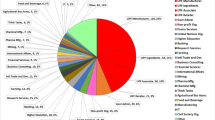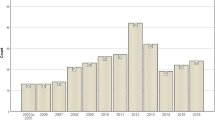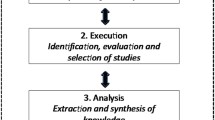Abstract
This article provides an historic snapshot of the evolution of global food and nutrition governance, with special attention to the global trends towards the increased participation of the private sector and the emergence of ‘multi-stakeholderism’. It explores the role different actors had in reducing the broad spectrum of food and nutrition policies into a package of nutrition interventions, mostly involving product-based strategies, and challenges such approaches from a holistic and human rights-based perspective.
Similar content being viewed by others
Notes
World Food Conference Final Report (1974, Rome).
Universal declaration on the eradication of hunger and malnutrition.
Universal declaration on the eradication of hunger and malnutrition.
See excellent article by Shaw (2011) which describes the details of the convoluted 20 years of the World Food Council.
The Heritage Foundation. How American Food Aid Keeps the Third World Hungry 1 August, 1988.
See PL 480 related US government resolutions in which the real intentions of the programme are unveiled at: https://apps.fas.usda.gov/excredits/quarterly/2000/mar-sum.html.
Gleckman, H. Personal communication.
Pior 2002, in Richter (2004) Public–private partnerships and international health policy making: How can public interests be safeguarded? Hakapaino Oy, Helsinki 2004.
Richter, J. ‘We the peoples’ or ‘we the corporations’? Critical reflections on UN-business partnerships. Geneva, IBFAN/GIFA (2003) http://www.ibfan.org/art/538-3.pdf (visited on 20 August 2018).
Richter, J. Comment on Draft Concept Note towards WHO's 13th General Programme of Work; http://www.gifa.org/wp-content/uploads/2017/11/JRichter_2017_Comment_WHO_dCNtGPW_11_14_FINAL.pdf (visited on 20/August 2018).
Richter, J. Comment on Draft Concept Note towards WHO's 13th General Programme of Work; http://www.gifa.org/wp-content/uploads/2017/11/JRichter_2017_Comment_WHO_dCNtGPW_11_14_FINAL.pdf (visited on 20/August 2018).
Lancet Maternal and Child Undernutrition in: https://www.thelancet.com/series/maternal-and-child-undernutrition?code=lancet-site (visited on 20 August 2018).
While SCN’s constituencies had nothing against prioritizing the first 1000 days of life of a baby, as proposed by GAP and later SUN, they simply questioned the lack of a human rights orientation of both initiatives, and their heavy emphasis on using products such as RUTF and food supplements. The companies providing these are usually based in Western Europe and Northern America.
Report available at: www.unscn.org/en/publications/2020_commission_report/.
The consultations made to the different SCN working groups are mentioned in the Recommendations from the 35th Session ‘Accelerating the Reduction of Maternal and Child Undernutrition’ in: https://www.unscn.org/web/archives_resources/files/scnnews36.pdf p. 51 (visited on 20 August 2018).
For excellent critical pieces on the discrediting of the SCN (WPHNA 2011a).
The first of a series of bilateral free trade agreements which negatively impacted the capacity of national governments to promote and protect the food and nutritional security of those inhabiting their territories (Navarro 2007).
Ms Veneman strongly defended the se of Plumpy nut in nutrition programs in SCN 34 session. See: UNSCN SCN News 35. End 2007. Geneva; Available in: https://www.unscn.org/web/archives_resources/files/scnnews35.pdf (visited on 27 July 2018).
See IBFAN on the independence of The Lancet Nutrition Series in: http://info.babymilkaction.org/update/update46 (visited on 27 July 2018).
UNSCN SCN News 36 mid 2008. Geneva. Available in: https://www.unscn.org/web/archives_resources/files/scnnews36.pdf (visited on 27 July 2018).
At the time, only a half-page document was submitted to members of the SCN, informing about the implementation of an internal reform of the committee. The document stressed the necessity to ‘bring private sector representatives into all levels of the structure of new SCN’. (Virtual document).
For more information on the HLTF, please see: www.un-foodsecurity.org/structure. For a critical view, please see: FIAN International (2008a).
For more information on the food crisis, please see the first edition of the Right to Food and Nutrition Watch, ‘The World Food Crisis and the Human Right to Food’, from 2008. Available at: www.rtfn-watch.org/en/home/watch-2008/the-right-to-food-and-nutrition-watch-2008/.
G8 Efforts Towards Global Food Security: G8 Experts Group on Global Food Security. L’Aquila, Italy: 2009. Available at: www.g8italia2009.it/static/G8_Allegato/G8_Report_Global_Food_Security,2.pdf.
The FAO reform process ran from 2005 to 2012 (FAO 2013).
The Global Compact (GC) was an initiative created in 1999 during the WEF to strength cooperation between the UN and business enterprises. It is not a binding instrument, relying instead on voluntary engagement of the business sector, and has been vehemently criticized by social movements and civil society organizations at local and international levels. The GC in no way holds transnational corporations (TNCs) accountable for their activities’ impact on human rights worldwide. For a critical approach, see the activities of Corporate Europe Observatory (corporateeurope.org/) and CorpWatch (www.corpwatch.org/), two international NGOs involved in monitoring and denouncing TNCs’ threats to human rights.
The GRI also established the Global Agenda Councils on Food Security and on Nutrition that are mainly composed of members directly or indirectly connected to TNCs or international institutions like the WB or WTO. The Councils have for instance, representatives of Bunge, Coca-Cola, Nestlé, PepsiCo, and Unilever as their members. This illustrates the corporate capture of the food and nutrition agenda setting and governance (Birn and Richter 2018: 374).
Foot note 15, p. 367. www.unscn.org/en/publications/2020_commission_report/.
African Centre for Biosafety. The True Beneficiaries of AGRA’s ‘Soil Health Program.’ Right to Food and Nutrition Watch (2013): 20–21. Available at: www.fian.org/fileadmin/media/publications/Watch_2013_eng_WEB_final.pdf.
For detailed information on the business members of SUN, see: http://2fe0ur3bixo1clgx344dzbo3f.wpengine.netdna-cdn.com/wp-content/uploads/sites/2/2015/01/SBN-Company-Commitments1.pdf.
35th SCN Session Recommendations in: UNSCN. Accelerating the reduction of maternal and child undernutrition. SCN NEWS 36, mid-2008, pp. 51–57.
David Nabarro in UNSCN (2010).
David Nabarro in UNSCN (2010).
Prof Ted Greiner, personal communication.
In 2014, Bill and Melinda Gates Foundation provided a grant of USD 745,473 to the Secretariat of the CFS to support the discussion of Food and Nutrition Governance. For more information, see: www.gatesfoundation.org/How-We-Work/Quick-Links/Grants-Database/Grants/2014/06/OPP1103948.
CFS and its role advancing Nutrition (CFS, BurAG2015/02/02/03), presented in February 2015 to the CFS Bureau. Available at: www.csm4cfs.org/files/News/216/cfs_bur_ag_2015_03_02_03_cfs_and_its_role_advancing_nutrition_(1).pdf.
In 2014, she was appointed Chair of the Global Agenda Council for Food and Nutrition Security of the WEF, and from 2013 until 2015, she served as Chair of the UN Committee on World Food Security (CFS). In: http://sustainability.thomsonreuters.com/women/authors/gerda-verburg/ (visited on 20 August 2018).
Formerly, the SCN secretariat was coordinated by a senior Technical Secretary, allotted with a D1 position, i.e., post equivalent to that of the heads of nutrition divisions of all UN agencies, programs and funds. The former secretary, despite being a WHO employee, reported exclusively to the Chair of SCN. The new secretary has a P5 position and will have to report to the FAO Nutrition Division Head, substantially reducing her autonomy and inter agency standing. This fact also reduces significantly her summoning capacity in face of the nutrition heads of other agencies.
References
Bengoa, J.M. 1970. Recent Trends in the Public Health Aspects of Protein-Calorie Malnutrition. WHO Chron. 24 (12): 552–561.
Birn, Anne-Emanuelle and Judith Richter. 2018. U.S. Philanthrocapitalism and the Global Health Agenda: The Rockefeller and Gates Foundations, Past and Present. In Health Care under the Knife: Moving Beyond Capitalism for Our Health, eds. Howard Waitzkin and the Working Group for Health Beyond Capitalism. Monthly Review Press (electronic advance chapter was made available under) http://www.peah.it/2017/05/4019/ (visited on 20 August 2018).
CFS. 2009. Reform of the Committee on World Food Security: Final Version. Rome: CFS. www.fao.org/fileadmin/templates/cfs/Docs0910/ReformDoc/CFS_2009_2_Rev_2_E_K7197.pdf. Accessed 20 Aug 2018.
FAO. 2013. Final Management Report on Immediate Plan of Action Implementation and the FAO Reform Process. Rome: FAO. www.fao.org/docrep/meeting/027/mg067e.pdf. Accessed 20 Aug 2018.
FIAN International. 2008a. Time for a Human Right to Food Framework of Action. Heidelberg: FIAN. www.fian.org/fileadmin/media/publications/Time-for-a-Human-Right-to-Food-Framework-of-Action-2008.pdf. Accessed 20 Aug 2018.
FIAN International. 2008b. FIAN Challenges Comprehensive Framework of Action (CFA) Adopted by the High Level Task Force on Global Food Crisis. FIAN, 23 September. www.fian.org/en/news/article/detail/fian_challenges_comprehensive_framework_of_action_cfa_adopted_by_the_high_level_task_force_on_glob/.. Accessed 20 Aug 2018.
Hamdani, Khalil, and Lorraine Ruffing. 2015. United Nations Centre on Transnational Corporations: Corporate Conduct and the public interest. New York-London: Routledge.
International Baby Food Action Network (IBFAN). 2014. GAIN, a Wolf in Sheep’s Clothing, Will Try Once Again to Enter WHO’s Policy Setting Process. Geneva: IBFAN. ibfan.org/pr/Wolf-GAIN-PR.21.1.14.pdf. Accessed 20 Aug 2018.
Jonsson, Urban. 1981. The Causes of Hunger. Food and Nutrition Bulletin 03 (2): 1–9.
Longhurst, Richard. 2010. Global Leadership for Nutrition:The UN’s Standing Committee on Nutrition (SCN) and its Contributions. Discussion Paper Series, 390. Brighton: IDS.
Navarro, Luis Hernández. 2007. Tortilla Wars—Cargill and the (Not so Free) market. The Mex Files, 15 April. http://mexfiles.net/2007/04/15/tortilla-wars-cargill-and-the-not-so-free-market/. Accessed 20 Aug 2018.
Richter, Judith. 2003a. We the Peoples’ or ‘We the Corporations’? Critical Reflections on UN-Business Partnerships. Geneva, IBFAN/GIFA, http://www.ibfan.org/art/538-3.pdf (visited on 20 August 2018).
Richter, Judith. 2003b. Building on Quicksand: The Global Compact, Democratic Governance and Nestlé. Geneva & Zurich, CETIM (Centre Europe-Tiers Monde); IBFAN/GIFA, Berne Declaration (October, 2nd edition April 2004) http://www.ibfan.org/art/538-2.pdf (visited on 20 August 2018).
Richter, Judith. 2004. Public-Private Partnerships and Health for All: How can WHO Safeguard Public Interests? GASPP Policy Brief 5. www.ibfan.org/art/538-5.pdf. Accessed 20 Aug 2018.
Schuftan, Claudio and Radha Holla. 2012. Two Contemporary Challenges: Corporate Control Over Food and Nutrition and the Absence of a Focus on the Social Determinants of Nutrition. Right to Food and Nutrition Watch: 24–30. Available at: www.righttofoodandnutrition. org/files/R_t_F_a_N_Watch_2012_eng. pdf#page=24.
Shaw, D.John. 2011. The World Food Council: The Rise and Fall of a United Nations Body. Canadian Journal of Development Studies/Revue canadienne d’études du développement 30 (3–4): 663–694. https://doi.org/10.1080/02255189.2010.9669320.
Shiva, Vandana. 1991. The Violence of Green Revolution: Third World Agriculture, Ecology and Politics. London: Zed Books.
UNICEF. 1981. Programmes Proposed by UNICEF in Support of Breast-Feeding. Assignment Children 55–56: 19–24.
UNSCN. 2009. High Level Meeting on Nutrition. Organized by the UNSCN and Hosted by the European Commission 23–24 November, Brussels. https://www.unscn.org/files/Annual_Sessions/2009_Brussels/Brussels_High_Level_Nutrition_Meeting_report__final.pdf (visited on 27 July 2018).
UNSCN. 2010. UNSCN Nutrition Partners Kick-Off Meeting Report. December. Rome: FAO HQ. https://www.unscn.org/files/Activities/Other_Meetings/UNSCN_kick_off_meeting_minutes_14_15_Dec_2010.pdf (visited on 27 July 2018).
Waterlow, J.C. 1972. Classification and Definition of Protein-Calorie Malnutrition. British Medical Journal 3 (5826): 566–569.
Waterlow, J.C. 1976. Classification and Definition of Protein-Energy Malnutrition. Monogr Series World Health Organization 62: 530–555.
WEF. 2010. Everybody’s Business: Strengthening International Cooperation in a More Interdependent World: Report of the Global Redesign Initiative. Davos. www3.weforum.org/docs/WEF_GRI_EverybodysBusiness_Report_2010.pdf. Accessed 20 Aug 2018.
World Bank. 2006. Repositioning Nutrition as Central to Development. A Strategy for Large Scale Action. Washington, DC: World Bank. www.unhcr.org/45f6c4432.pdf. Accessed 20 Aug 2018.
World Public Health Nutrition Association (WPHNA). 2011a. United Nations Standing Committee on Nutrition: No Flowers Please. WPHNA. www.wphna.org/htdocs/2011_july_hp5_sun.htm. Accessed 20 Aug 2018.
World Public Health Nutrition Association (WPHNA). 2011b. Ann Veneman. USDA. UNICEF. SCN. Nestlé Public-Private Partnerships Personified. www.wphna.org/wp-content/uploads/2013/08/2011_March_Ann_Veneman_joins_Nestle.pdf. Accessed 20 Aug 2018.
Author information
Authors and Affiliations
Corresponding author
Additional information
This article was developed by the author in the context of a collaborative initiative between FIAN International, IBFAN and SID on ‘Assessing Multi-stakeholder Partnerships in Food, Agriculture and Nutrition from a Human Rights Perspective: The case of the Scaling-up Nutrition (SUN) Initiative’. A shorted version of this article is included in the final report of initiative (forthcoming). The initiative was implemented with the financial support of the Bread for the World, Misereor, Welthungerhilfe and the Open Society Institute.
Rights and permissions
About this article
Cite this article
Valente, F.L.S. Evolution on Food and Nutrition Governance and the Emergence of Multistakeholderism. Development 61, 68–83 (2018). https://doi.org/10.1057/s41301-018-0198-x
Published:
Issue Date:
DOI: https://doi.org/10.1057/s41301-018-0198-x




